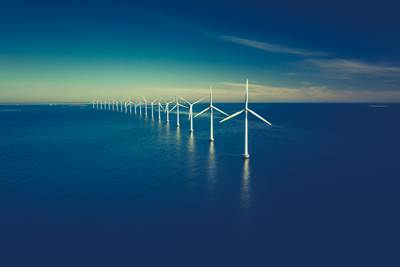Composites Use in Wind/Energy Markets
The wind energy market has long been considered the world’s largest market, by volume, for glass fiber-reinforced polymer (GFRP) composites — and increasingly, carbon fiber composites — as larger turbines and longer wind blades are developed, requiring higher performance, lighter weight materials. The outer skins of wind and tidal turbine blades generally comprise infused, GFRP laminates sandwiching foam core. Inside the blade, rib-like shear webs bonded to spar caps reinforce the structure. Spar caps are often made from GFRP or, as blade lengths lengthen, pultruded carbon fiber for additional strength.

Latest Wind/Energy Articles
VIEW ALLAcciona Energía’s Forty Mile wind farm begins operations
The renewable energy company’s largest wind facility built to date in North America features 49 Nordex turbines each with a capacity of 5.7 megawatts.
Read MoreJapan certifies Proteus tidal turbine, now exporting power to national grid
Following installation in the Naru Strait, the composite-bladed, 1.1-megawatt turbine has met all national requirements for safety and performance, a milestone to further tidal generation capacity.
Read MoreIsodan mobile recycling plant supports fiberglass, composites processing at Greater Renewable of Iowa
Now operational, the containerized plant enables GRI to process up to 20,000 pounds of end-of-life wind blades per shift, opening the way for repurposing opportunities.
Read MoreExel Composites supports resilience of biomimetic hydrokinetic system by EEL Energy
Exel adapted carbon fiber profiles originally designed for wind turbines to meet the low-drag, high-flexibility and long-term fatigue performance demands of this renewable energy system’s nature-inspired membrane.
Read MoreRWC delivers composite frac plugs for downhole environments
Filament-wound fiberglass/epoxy frac plug billets, developed as part of a contract with an oilfield service company, address the very demanding performance needs of oil and gas.
Read MoreGWEC launches 2025 global wind report
Despite a year of headwinds, 2024 still enjoyed another record year of wind energy installation globally. Even so, the Global Wind Energy Council report offers a data-led roadmap to triple growth and meet COP28 targets.
Read MoreKnowledge Centers

CompositesWorld’s CW Tech Days: Infrastructure event offers a series of expert presentations on composite materials, processes and applications that should and will be considered for use in the infrastructure and construction markets.
LEARN MORELatest Wind/Energy News And Updates
Siemens Energy installs 21-MW offshore turbine prototype, reports say
Numerous sources indicate that Siemens Gamesa may be making headway with a previously noted 21-MW wind turbine with a 276-meter rotor which would put it ahead of competitors.
Read MoreÉireComposites, University of Galway launch R3WIND project
Renewable energy initiative will design, develop and demonstrate novel repair and recycling techniques of onshore and offshore wind blades using sustainable manufacturing processes.
Read MoreWe4Ce designs rotor blades for TouchWind’s floating one-piece rotor turbine
Tiltable, liftable one-piece composite rotor design aims to withstand storm-force winds, boost energy yield and enable more compact offshore wind farms.
Read MoreSiemens Gamesa to divest 90% of Indian wind business to TPG
In light of the rapidly growing wind sector in India, Siemens Gamesa has chosen to transfer majority ownership to TPG, a partner with financial strength and extensive experience in the Indian market.
Read MoreTidalHeath project supports SHM advancements in tidal turbine foils
ÉireComposites, University of Galway and ORPC are dedicated to improving real-time damage detection and monitoring of composite tidal foils through innovations in 3D printed fiber optic sensors and foil designs.
Read MoreProteus Marine Renewables installs Japan’s first 1.1-megawatt tidal turbine
Carbon fiber tidal turbine generator, featuring a horizontal-axis rotor with three composite blades, drives Japan’s transition to tidal energy.
Read MoreFeatured Posts
Recycled carbon fiber composite panels power 40% lighter, durable semi-rigid solar panels
Designed for auxiliary power use while traveling via boat or RV, Italian startup Levante’s custom flexible or standardized semi-rigid solar panels combine the benefits of ReCarbon’s rCF and thermoplastics.
WatchIn oil and gas, an additive manufacturing standard (API 20T) will aid adoption of composites
Polymer AM equipment maker Roboze sees how the oil and gas industry’s way forward with additive is like that of another high-stakes industry, aerospace, and also different in important aspects.
WatchHigh-tension, vertical filament winding enables affordable flywheel energy storage system
French startup Energiestro’s prototype solar energy flywheel-based storage system aims to reduce costs with glass fiber composites and prestressed concrete.
WatchPlant tour: Hexagon Purus, Kassel, Germany
Fully automated, Industry 4.0 line for hydrogen pressure vessels advances efficiency and versatility in small footprint for next-gen, sustainable composites production.
Read MoreComposite bipolar plates provide 81% improvement to hydrogen fuel cell power density
Ultra-thin CFRTP plates developed by Hycco achieve a 7.5 kilowatt/kilogram power density, high durability for fuel cells in long-flight drone and heavy-mobility applications.
Read MoreSRI develops scalable, infiltration-free ceramic matrix composites
Work in two DOE projects is demonstrating C/C-SiC produced in 3-5 days with <5% shrinkage, <10% porosity and 50% the cost of conventional C/C and C/C-SiC.
Read MoreFAQ: Wind/Energy
What are wind turbine blades made from?
- The outer skins of wind and tidal turbine blades generally comprise infused, GFRP laminates sandwiching foam core. Inside the blade, rib-like shear webs bonded to spar caps reinforce the structure. Spar caps are often made from GFRP or, as blade lengths lengthen, pultruded carbon fiber for additional strength.
- Source: Composites end markets: Renewable energy
What energy applications are composites used for?
In renewable energy, fiberglass composites are used, most prominently, to build wind turbine blades and nacelles. Carbon fiber composites are also used to build wind blade spar caps. Hydroelectric turbines, tidal energy turbines and other forms of renewable energy have also made use of composites.
In oil and gas, composites have long been used as a corrosion-resistant metal alternative for a number of applications, including components for protecting wellheads, manifolds and other equipment related to subsea processing, and offshore pipelines themselves.
What happens to wind blades at the end of their lifespan?
As wind energy ramps up, recycling of composite wind blades at their end of life (EOL) – as well as composites and plastics recycling in general – continues to be a topic of concern.
More than 80% of a wind turbine itself is typically metallic and recyclable, but the increasingly long, high-performance composite blades pose more of a challenge.
Efforts include:
-
-
- Near-term: Ramping up existing recycling methods like mechanical chopping up blades or repurposing entire blades for other uses
- Medium-term: Developing more efficient methods such as chemical recycling (solvolysis) for reclaiming the original fibers from EOL blades for reuse
- Long-term: Designing and manufacturing wind blades with sustainable/recyclable materials
-





































